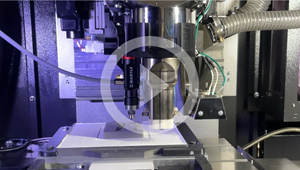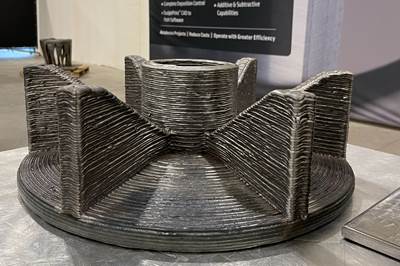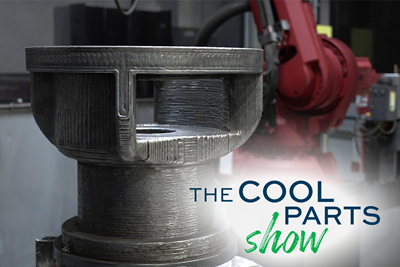Robot Deposition Makes Giant Industrial Mixer Blade: The Cool Parts Show Bonus
Wire arc additive manufacturing produces a large component formerly made through casting, and allows for redesign of its internal cooling geometry.
Share
How does an industrial processing facility replace a giant mixer blade when the foundry tooling has been damaged? Welding technology supplier Lincoln Electric turned to additive manufacturing. The blade is part of a mixer for producing flux, a granulate used in welding. The blade wears out over time — and the latest replacement was made by the company’s own Lincoln Electric Additive Solutions through metal 3D printing with a robot via metal arc additive manufacturing (WAAM). On a recent episode of The Cool Parts Show, we looked at the flux mixer bearing housing, also made with WAAM. Here is a bonus follow-up to that episode on the mixer blade we also saw during our time at Lincoln Electric, and how 3D printing allowed the company to improve the design on the inside of this massive steel part. | This episode of The Cool Parts Show brought to you by Carpenter Additive
The Cool Parts Show is a video series from Additive Manufacturing Media that explores the what, how and why of unusual 3D printed parts. Watch more here.
Have a cool part to share? Email us.
Related Resources
-
Episode of The Cool Parts Show on the flux mixer bearing housing
- More on wire arc additive manufacturing
Transcript
Peter Zelinski
I'm Pete.
Stephanie Hendrixson
I'm Stephanie.
Peter Zelinski
Welcome to a bonus episode of The Cool Parts Show.
Stephanie Hendrixson
This is a follow up to an episode we recently filmed on site at Lincoln Electric in Cleveland, Ohio. If you haven't seen that episode, you can find a link to it in the show description and also on our YouTube channel.
But just to quickly recap, we went to Lincoln Electric to see this bearing housing. This was a part for a very old mixer, a piece of equipment that's been in service for a long time. And that original component had cracked.
So Lincoln Electric, fortunately, also does this thing called wire arc additive manufacturing or WAAM. So they were able to scan that original part, make a few design improvements, and then 3D print a replacement through this process. But while we were there filming on site, we also got to learn about another interesting application for WAAM.
Peter Zelinski
While we were there, we found this. This is the mixer blade to that very same machine. Also, the replacement version of it is being made through metal 3D printing, through wire arc additive manufacturing.
Stephanie Hendrixson
So the interesting thing here is that that bearing housing that we went there to see originally, that was an original part. It was very old and so there was no CAD file, there were no blueprints, there was probably no foundry tooling that anybody could have found.
And this mixer blade is a little bit of a different situation. This is a consumable part. This is something that Lincoln Electric replaces from time to time. They've had it manufactured conventionally in the past. And in fact, there was tooling at a foundry that existed.
The issue was that the tooling had been damaged since it was used last. And so Lincoln was facing this decision between investing a lot of time and money into getting new foundry tooling or looking at WAAM as a possible alternative.
Peter Zelinski
Right. And so the additive manufactured version of this component, this mixer blade, using additive allowed them to introduce some engineering improvements. Then and now this mixer blade has had internal channels for cooling water to help keep it cool while it's doing the mixing.
In the past, the previous version of that part, those internal passages were made through drilling. Drill holes from the outside, they interconnect to make those inside passages, plug the outside parts of the hole so the inside channel is all that's left.
3D printing, just print those passages in where you want them, how you want them. No need for external sealing as a separate step, but also, maybe more importantly, those passages on the inside for the cool water don't have to be round anymore, which is all you would get from a drill, obviously.
But now they conform to the shape of that blade. This 3D printed version of the mixing blade is liable to last longer because the cooling is better, the thermal dynamics are better.
Stephanie Hendrixson
Yeah, so think about conformal cooling, but on a really large scale. And speaking of scale, this mixer blade is big. It takes 11 days to 3D print it, which is quite a bit of time, but it's still probably faster than they could have gotten new foundry tooling and had it cast conventionally.
The other thing that's interesting about wire arc additive manufacturing that is evident in this part is that you have this whole range of motion. So you have a deposition head that's on a robotic arm. So you get the full range of motion of the robot.
But you can also at the same time manipulate the part as it's being printed. And you can see how they use that to their advantage in this mixer blade, like how the layer lines change direction and how they wrap around these different corners and angles in its geometry.
Peter Zelinski
So that's right. So look at this bearing surface at one end of the blade. So the part was held on that surface for the most part while it was being 3D printed, it kind of, it grew up from that surface. And yeah, you get in close and you see how the layer lines are not parallel at all. They go in all different directions as the part is being turned and pivoted while it's being produced. At the same time that the robot head is, is pivoting and articulating around the part. And what all that shows is what the solution consists of, what Lincoln Electric Additive Solutions has achieved here with their WAAM process, it is more than the hardware solution of attaching a welding 3D printing head to a robot. It is every bit as much a software solution. The programming software that enables the robot and the work holding in conjunction to achieve all of these different metal deposition tool paths, torch paths, actually, that realize this part.
Related Content
3D Printed Cutting Tool for Large Transmission Part: The Cool Parts Show Bonus
A boring tool that was once 30 kg challenged the performance of the machining center using it. The replacement tool is 11.5 kg, and more efficient as well, thanks to generative design.
Read More3D Printed NASA Thrust Chamber Assembly Combines Two Metal Processes: The Cool Parts Show #71
Laser powder bed fusion and directed energy deposition combine for an integrated multimetal rocket propulsion system that will save cost and time for NASA. The Cool Parts Show visits NASA’s Marshall Space Flight Center.
Read MoreDMG MORI: Build Plate “Pucks” Cut Postprocessing Time by 80%
For spinal implants and other small 3D printed parts made through laser powder bed fusion, separate clampable units resting within the build plate provide for easy transfer to a CNC lathe.
Read More3D Printing Molds With Metal Paste: The Mantle Process Explained (Video)
Metal paste is the starting point for a process using 3D printing, CNC shaping and sintering to deliver precise H13 or P20 steel tooling for plastics injection molding. Peter Zelinski talks through the steps of the process in this video filmed with Mantle equipment.
Read MoreRead Next
The Way Ahead for Wire Arc Additive Manufacturing
Tooling today, production tomorrow. The capability will advance as value is increasingly seen in lead time savings and design opportunities. Parts that today are cast offer a particularly promising application for a process that is “welding, except not.”
Read More500-Pound Replacement Part 3D Printed by Robot: The Cool Parts Show #50
Our biggest metal cool part so far: Wire arc additive manufacturing delivers a replacement (and upgrade) for a critical bearing housing on a large piece of industrial machinery.
Read MoreWhy Robots and Additive Manufacturing Go Together
3D printing and robots enable one another. We miss the possibilities of one if we do not consider the other. The combination includes AM for end effectors, robots for 3D printing parts, and different modes of metal and plastic production.
Read More












